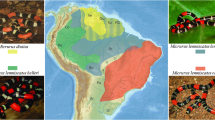Abstract
This study determined the effect of decamethonium bromide (DMBr), a non-competitive blocker of the neuromuscular junction, on skeletal muscle development during chick embryogenesis. Decamethonium bromide caused generalized edema and high mortality with treated embryos rarely surviving beyond day 16 of incubation. Muscle degeneration was grossly evident on the muscles of abdomen, pectoral girdle, and leg. Semi-thin sections showed a high infiltration of macrophages in treated embryos and a massive degenerative process. Electron microscopy showed that both fast and slow fibers formed in the control and treated embryos, but those of the treated embryos failed to form myofibrils. Other organ systems, such as the heart and the gut, appeared histologically normal throughout the course of treatment. To investigate possible nerve independent action of DMBr on muscle development we determined the effect of this compound on the growth and differentiation of the C2C12 skeletal muscle cell line. DMBr treatment of C2C12 cell cultures did not affect the growth or survival of the cells, even at a tenfold higher concentration than that used in ovo, but myosin heavy chain expression was dramatically inhibited. We conclude that DMBr has a nerve independent blocking inhibition effect on myosin heavy chain synthesis in the developing avian embryo besides the recognized role as a non-competitive post-synaptic blocker of the neuromuscular junction.







Similar content being viewed by others
References
Ashby PR, Wilson SJ, Harris AJ (1993) Formation of primary and secondary myotubes in aneural muscles in the mouse mutant peroneal muscular atrophy. Dev Biol 156:519–528
Betz WJ, Ribchester RR, Ridge RMAP (1990) Competitive mechanism underlying synapse elimination in the lumbrical muscle of the rat. J Neurobiol 21:1–17
Brand-Saberi B, Christ B (1993) Inhibition of myogenic cell migration by the application of antibodies raised against limb bud mesenchyme. Limb development and regeneration. Wiley-Liss, New York, pp 541–522
Brand-Saberi B, Gamel AJ, Krenn V, Muller TS, Wilting J, Christ B (1996) N-Cadherin is involved in myoblast migration and muscle differentiation in the avian limb bud. Dev Biol 178:160–173
Buckingham M (1994) Which myogenic factors make muscle? Curr Biol 4:61–63
Condon K, Silberstein L, Blau HM, Thompson WJ (1990) Differentiation of fibre types in aneural musculature of the prenatal rat hind limb. Dev Biol 138:275–295
Crow MT, Stockdale FE (1986) Myosin expression and specialization among the earliest muscle fibres of the developing avian limb. Dev Biol 133:238–254
Dimario JX, Fernyak SE, Stockdale FE (1993) Myoblasts transferred to the limbs of embryos are committed to specific fibre fates Nature Lond 362:165–167
Duxson MJ, Usson Y, Harris AJ (1989) The origin of secondary myotubes in mammalian skeletal muscles: ultrastructural studies Development 107:743–750
Fredette BJ, Landmesser LT (1991a) Relationship of primary and secondary myogenesis to fibre type development in the embryonic chick muscle. Dev Biol 143:1–18
Fredette BJ, Landmesser LT (1991b) A re-evaluation of the role of innervation in primary and secondary myogenesis to fibre type development in embryonic chick muscle. Dev Biol 143:19–35
Grinell AD (1995) Dynamics of muscle nerve interaction in developing and mature neuromuscular junctions. Phys Rev 75:789–834
Harris AJ (1981) Embryonic growth and innervation of rat skeletal muscles. I. Neural regulation of muscle fibre numbers. Philos Trans R Soc London Ser B 293:257–277
Hosseini A, Hogg DA (1991) The effects of paralysis on skeletal development in the chick embryo. I. General effects. J Anat 177:159–168
Hughes DS, Ontell M (1992) Morphometric analysis of the developing murine aneural soleus muscle. Dev Dyn 193:175–184
Kelly AM, Zacks SI (1969) The fine structure of motor endplate morphogenesis. J Cell Biol 42:154–169
Laughlin MH, Schrage WG (1999) Effect of muscle contraction on skeletal muscle blood flow: When is there a muscle pump? Med Sci Sports Exerc 31:1027–1035
Macharia RG, Warui CN, Kisia SM (1998) Effects of decamethonium bromide induced paralysis on the development skeleton in the chick embryo. Kenya Vet 23:61–63
McLellan IS (1982) Size of motorneuron pool may be related to number of myotubes in developing muscle. Dev Biol 92:263–265
McLellan IS (1983) Neural dependence and independence of myotube production in the chicken hind limb muscles. Dev Biol 98:287–294
Miller JB, Stockdale FE (1986) Developmental regulation of the multiple myogenic cell lineages of the avian embryo. J Cell Biol 103:2197–2208
Mishra Y, Ramzan I (1993) Interaction between famotidine and neuromuscular blockers: an in vivo study in rats. Anesth Analg 77: 780–783
Rao J, Otto WR (1992) Fluorimetric DNA assay for cell growth estimation. Anal Biochem 207:186–192
Ross JJ, Duxson MJ, Harris AJ (1987) Neural determination of muscle fibres numbers in embryonic rat lumbrical muscles. Development 100:395–409
Rubinstein NA, Kelly AM (1981) Development of muscle fibre specialisation in the rat hind limb. J Cell Biol 90:128–144
Salmons F, Sreter FA (1976) Significance of impulse activity in the transformation of skeletal muscle type. Nature Lond 263:30–34
Soileau LC, Silberstein L, Blau HM, Thompson WJ (1987) Reinnervation of muscle fibre types in the newborn rat soleus. J Neurosci 7:4176–4194
Stockdale FE, Nikovits W Jr, Christ B (2000) Molecular and cellular biology of the avian somite development. Dev Dyn 219:304–321
Tanaka H, Landmesser TL (1986) Cell death in the lumbosacral motorneurons in chick, quail and chick quail chicken embryos. A test of quantitative matching hypothesis of neuronal cell death. J Neurosci 6:2889–2899
Vickers MD, Morgan M, Spencer PSJ (eds) (1991) Drugs in anaesthesia, 7th edn. Butterworth-Heinemann, London, pp 253–257
Wilson SJ, Harris AJ (1993) Formation of myotubes in aneural rat muscles. Dev Biol 156:509–518
Acknowledgements
We thank F. Stockdale for the antibody samples S46 and F59. We also thank Mr. G. Frank, Mrs. S. Antoni, L. Koschny, and Mrs. E. Gimbel for their excellent technical assistance, and Mrs. C. Micucci for the photographic work. This study was supported by a grants from DAAD and Wellcome Trust (066195/Z/01/Z) to RM and a grant from the Deutsche Forschungsgemeinschaft (SFB 596, A1) to B.C.
Author information
Authors and Affiliations
Corresponding author
Rights and permissions
About this article
Cite this article
Macharia, R., Patel, K., Otto, W.R. et al. Decamethonium bromide-mediated inhibition of embryonic muscle development. Anat Embryol 208, 75–85 (2004). https://doi.org/10.1007/s00429-003-0362-1
Accepted:
Published:
Issue Date:
DOI: https://doi.org/10.1007/s00429-003-0362-1




